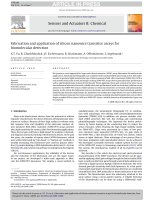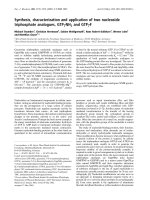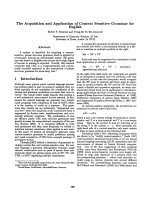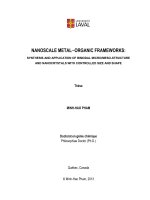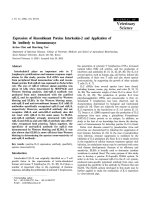Fabrication and application of giant magnetoresistance spin valve
Bạn đang xem bản rút gọn của tài liệu. Xem và tải ngay bản đầy đủ của tài liệu tại đây (6.45 MB, 100 trang )
國 立 高 雄 科 技 大 學
機械工程系博士班
博士論文
巨磁阻自旋閥的製作與應用
Fabrication and Application of Giant Magnetoresistance Spin-Valve
研究生
指導教授
:鄭春勝
:鄭振宗 教授
許仁華 教授
中華民國 108 年 1 月
巨磁阻自旋閥的製作與應用
Fabrication and Application of Giant Magnetoresistance Spin-Valve
研究生:鄭春勝
指導教授:鄭振宗 教授
許仁華 教授
國立高雄科技大學
機械工程系博士班
博士論文
A Thesis
Submitted to
Department of Mechanical Engineering
National Kaohsiung University of Science and Technology
in Partial Fulfillment of the Requirements
for the Degree of
Doctoral of Philosophy
in
Mechanical Engineering
Jan 2019
Kaohsiung, Taiwan, Republic of China
*National Kaohsiung University of Applied Sciences is the predecessor of
National Kaohsiung University
of Science and Technology (renamed on Feb. 1, 2018)
中華民國 108 年 1 月
巨磁阻自旋閥的製作與應用
學生:鄭春勝
指導教授:鄭振宗 博士
許仁華 博士
國立高雄科技大學機械工程所博士班
摘
要
關鍵字:磁傳感器,GMR 傳感器,自旋閥,三軸磁力計,電子羅盤,位置
跟踪,渦流探頭。
本研究製作了巨磁阻(GMR)自旋閥裝置,並對其在三軸磁力計,渦流探
頭和位置跟踪中的性能進行了分析。通過使用直流磁控濺射沉積自旋閥 GMR
膜以形成多層結構。本工作中使用的自旋閥結構為 Si / SiO2 | Ta(5nm)|
NiFe(3nm)| Co(0.5nm)| Cu(x nm)| CoFe(2.5nm)| IrMn(10nm)|
Ta( 2nm),Cu 層厚度 x = 2.4, 2.6 和 2.8 nm。GMR 自旋閥傳感器係採用掀
離製程將圖案化為 3×100 μm 的磁場敏感元件,頂部的磁通匯聚器層是由
NiFe 材料製成。透過磁阻和 VSM 曲線量測驗證了 GMR 薄膜的傳輸特性,數據
顯示可達成的最大磁阻比約為 8%。三維磁力計的應用使用三個 GMR 傳感器進
行展示,此三個傳感器配置在同一平面上,共用一個磁通導引器。以電磁模
擬分析探討了磁通導引器的磁通彎曲效應,並應用線性變換校準以實現三軸
磁力計的正交感測方向。本研究亦展示了 GMR 自旋閥傳感器的其他應用,包
括使用梯度磁場的位置跟踪系統和用於探傷的渦流探頭。在位置跟踪系統中,
GMR 傳感器用於檢測具有 1kHz 正弦波激發梯度場的 z 分量,以相位敏感偵測
器解析同相和正交相位之梯度場 Bi 和 Bq 來確定傳感器的位置,傳感器的座標
顯示在 LabVIEW 編寫的圖形介面軟件上。 GMR 自旋閥傳感器也適用於探傷應
i
用中的渦流探頭,缺陷的位置可由微分缺陷場的最大振幅指出,而深度則可
由微分缺陷場的相位解析。
ii
Fabrication and Application of Giant Magnetoresistance Spin-Valve
Student: Xuan Thang Trinh
Advisors: Prof. Jen-Tzong Jeng
Co-advisors: Prof. Jen-Hwa Hsu
Department of Mechanical Engineering
National Kaohsiung University of Science and Technology
ABSTRACT
Keyword: Magnetic sensor, GMR sensor, spin-valve, tri-axis magnetometer,
electronic compass, position tracking, eddy current probe.
In this study, the giant magnetoresistance (GMR) spin-valve devices were
fabricated and characterized, and their performance in tri-axis magnetometer, eddy
current probe, and position tracking were analyzed. The spin-valve GMR film was
deposited by using the DC magnetron sputtering system. The structure of spin-valve
used in this work were Si/SiO2|Ta (5nm)|NiFe (3nm)|Co (0.5nm)|Cu (x nm)|CoFe
(2.5nm)|IrMn (10nm)|Ta (2nm) with Cu layer thickness x = 2.4, 2.6, and 2.8nm. The
GMR spin-valve sensor was patterned into the field sensitive cell of 3 ì 100 àm by
using the lift-off fabrication process. The flux concentrator layer on the top was made
of NiFe material. The transport properties of GMR film was demonstrated by
magnetoresistance (MR) and vibrating-sample-magnetometer (VSM) data. The
maximum magnetoresistance ratio achieved was about 8%. The application in the
three-dimensional magnetometer was demonstrated using three GMR sensors
mounted on the same plane with a flux-guide. The flux bending effect of flux-guide
was analyzed using electromagnetic simulation. The linear transform calibration was
applied to achieve orthogonal sensing directions for the tri-axis magnetometer. The
other applications of GMR spin-valve sensors were also demonstrated, including the
iii
position tracking system using the gradient magnetic field and the eddy current probe
based GMR spin-valve sensor for the flaw detection. In the position tracking system,
the GMR sensor was used to detect the z-component of the gradient field with 1kHz
sinewave excitation signal. The position of sensor is determined by detecting the inphase and quadrature-phase gradient field Bi and Bq with a phase sensitive detector.
The coordinates of sensor were displayed on GUI software coded by LabVIEW. The
GMR spin-valve sensor was also applied for eddy current probe in the flaw detection
application. The location of the flaws was determined by the maximum amplitude of
differential defect field while the depth of the flaws can be determined by the phase
of differential defect field.
iv
Acknowledgments
Firstly, I would like to thank especially my advisor, Prof. Jen-Tzong Jeng, for
his guidance and support during my study times at NKUST, Taiwan. He is always
supportive and gives me the opportunity to expand my knowledge of the fields
related to magnetic sensors. I would also like to extend my thanks to my Co-advisor,
Prof. Jen-Hwa Hsu, for his guidance, supports and giving valuable advice for me in
my working time at NTU to fabricate GMR sensor as well as his advice for my
dissertation. Next I would like to thank Prof. Lance Horng, Prof. Chih-Cheng Lu,
Prof. Ssu-Yen Huang and Prof. Chin-Tai Chen for accepting to be the committee
members for my thesis defense.
I would like to extend my special thanks to all of the members of the Micro
Magnetic Technologies Laboratory (MMTLab), Department of Mechanical
Engineering at National Kaohsiung University of Science and Technology. First, I
would like to thank Ph.D Van Su Luong for his introducing me to join MMTLab. He
has been instructed me to use the equipment in the laboratory, as well as giving me
valuable advice during the study and research process. Second, I would like to send
the special thanks to my Taiwanese in MMTLab, Mr. Bor-Lin Lai, Ms. Chia-Yi
Chang, Mr. Wei-Chun Chang, Mr. Jyun-Kai Wang, Mr. Bo-Chen Chen, Mr. Min-Jia
Lan, Mr. Guan-Wei Huang, Mr. Yi-Shian Chiang, Jing-Yuan Chen, and Tsang-Hao
Tsao for their help and support to me during the studying time in Taiwan. I would
like to say a lot of thanks to all of my Vietnamese friends and colleagues at NKUST
for sharing and helping me over the past few years.
Moreover, I also would like to send my thanks to Prof. Ssu-Yen Huang and his
students in Spintronic Laboratory, they have been helped me many things, as well as
facilitating me to use the machines in Spintronic Lab during my working time for
fabrication the GMR sensor at Department of Physics, National Taiwan University.
I would like to thank Prof. Chih-Cheng Lu for facilitating me using the devices
in Advanced Microsystems and Devices Laboratory (AMD Lab) at Institute of
Mechatronic Engineering, National Taipei University of Technology (NTUT) to
v
pattern the sensors, and my thanks to Mr. Chih-Hsien Hung, who was my co-worker
in the fabrication for GMR sensor.
The last thanks, it is indispensable for my great family, for my venerable parents.
Especially for my beloved wife, Mrs. Nguyen Thi Huong, who is always with me
and the motivation for me to complete my studies in Taiwan.
In addition, my work has been supported by the Ministry of Science and
Technology of Taiwan under Grant Nos. MOST 104-2221-E-151-011, MOST 1042221-E-027-059, MOST 106-2221-E-992 -342, MOST 106-2221-E-151 -025 and
MOST 106-2221-E-027 -060.
vi
Contents
ABSTRACT ..........................................................................................................iii
Acknowledgments ................................................................................................. v
Contents ............................................................................................................... vii
List of Figures ....................................................................................................... x
Chapter 1: Introduction ....................................................................................... 1
1.1. Applications of magnetic sensor ............................................................................ 1
1.1.1 Induction coil ....................................................................................................... 2
1.1.2. Fluxgate sensor ................................................................................................... 3
1.1.3. Giant Magnetoimpedance (GMI) ........................................................................ 4
1.1.4. SQUID ................................................................................................................ 5
1.1.5. Hall effect sensor ................................................................................................ 6
1.2. Overview of Magnetoresistance ............................................................................ 8
1.2.1. Ordinary Magnetoresistance ............................................................................... 8
1.2.2. Anisotropic Magnetoresistance (AMR) .............................................................. 9
1.2.3. Giant Magnetoresistance (GMR) ...................................................................... 11
1.2.4. Tunnel Magnetoresistance (TMR) .................................................................... 14
1.3. Motivation of study .............................................................................................. 15
Chapter 2: Fabrication of GMR Spin-Valve ................................................... 17
2.1. Film structure of GMR spin-valve ....................................................................... 17
2.1.1. Spin-valve structure .......................................................................................... 17
2.1.2. Behavior of GMR spin-valve sheet film ........................................................... 18
2.2. GMR spin-valve fabrication process ................................................................... 19
2.2.1. Patterning methods ........................................................................................... 19
2.2.2. Photolithography process .................................................................................. 21
a. Cleaning, coating and soft baking ........................................................................... 21
b. Exposure ................................................................................................................. 22
c. Development and hard baking ................................................................................ 22
2.2.3. Film deposition process .................................................................................... 23
2.2.4. Patterning using the lift-off method .................................................................. 25
vii
2.2.5. Field annealing process ..................................................................................... 25
2.3. Characteristic of GMR films................................................................................ 26
a. Measurement of magnetic ....................................................................................... 27
b. Magnetoresistance (MR) measurement .................................................................. 28
Chapter 3: Design of GMR-based Sensing Systems ........................................ 30
3.1. Miniature tri-axis magnetometer with in-plane GMR sensors ............................ 30
3.1.1. Tri-axis magnetometer design .......................................................................... 30
3.1.2. Simulations of flux bending effect .................................................................... 31
3.1.3. Calibration algorithms ...................................................................................... 35
3.2. Eddy current probe for flaw detection ................................................................. 36
3.2.1. Design of eddy current probe based on GMR spin-valve sensor ..................... 36
3.2.2. Working principle ............................................................................................. 38
3.3. Position tracker using GMR sensor ..................................................................... 38
3.3.1. Design of position tracker system ..................................................................... 38
3.3.2. Working principle ............................................................................................. 45
3.3.3. Linearity correction algorithm .......................................................................... 48
Chapter 4: Results and Discussion .................................................................... 52
4.1. Characterization of GMR films ........................................................................... 52
4.1.1. Sheet films ........................................................................................................ 52
a. Characterization of sheet film ................................................................................. 52
b. Dependence of MR on the spacer layer thickness. ................................................. 54
4.1.2. Patterned films .................................................................................................. 55
4.2. Characterization of miniature 3D magnetometer using in-plane GMR sensor ... 57
4.2.1. Sensitivity and noise of tri-axis magnetometer. ................................................ 57
4.2.2. Azimuth response of 3D magnetometer in electronic compass application ..... 59
4.3. Flaw detection with the GMR-based eddy-current probe .................................... 64
4.4. Position tracking with GMR sensors ................................................................... 66
Chapter 5: Conclusions and Outlook ............................................................... 70
Appendixes .......................................................................................................... 73
List of Publication ............................................................................................... 76
viii
Conference Presentation .................................................................................... 76
References............................................................................................................ 78
ix
List of Figures
Figure 1- 1. Classification of the magnetic sensors based on their detectable ability
[10]. ........................................................................................................................... 1
Figure 1- 2. Illustration of the operating principles of basic fluxgate sensor. ........... 3
Figure 1- 3. Configuration of GMI measurement system. ........................................ 4
Figure 1- 4. Comparision of RF and DC SQUID ring [36]. ...................................... 6
Figure 1- 5. The working principle of Hall effect sensor. ......................................... 7
Figure 1- 6. AMR sensor (a) the relation of resistance to angle θ between the
magnetization and the current flow direction; (b) angle θ in the case without an
applied field (c) change in θ with a applied external magnetic field [49]. ................ 9
Figure 1- 7. The GMR film structures. (a) Sandwich, (b) spin-valve and (c) multilayer
[55]. ......................................................................................................................... 11
Figure 1- 8. The scattering of spin-up and spin-down electrons in GMR effect: (a)
the scattering events occurring in the magnetic layers, and (b) the two-current
resistors model. ........................................................................................................ 13
Figure 1- 9. Illustration for the operation of TMR sensor. ...................................... 14
Figure 2- 1. The film structure of GMR spin-valve. ............................................... 17
Figure 2- 2. MR loop of GMR spin-valve film. (a) Major loop and (b) minor loop.
................................................................................................................................. 19
Figure 2- 3. The steps of patterning process for microfabrication using the lift-off
method. .................................................................................................................... 20
Figure 2- 4. The basic steps of the photolithography process. ................................ 21
Figure 2- 5. Photolithography process with (a) positive photoresist, and (b) negative
photoresist. .............................................................................................................. 22
Figure 2- 6. Configuration and working principle of the DC magnetron sputtering
machine with multiple- cathodes. ............................................................................ 23
x
Figure 2- 7. The DC magnetron sputtering machine at NTU. ................................. 24
Figure 2- 8. Magnetic field annealing machine at Spintronic Lab, NTU ................ 26
Figure 2- 9. The diagram of vibration sample magnetometer (VSM) system. ....... 27
Figure 2- 10. Four probes measurement system for GMR spin-valve film ............ 28
Figure 2- 11. MR measurement system at NTU. .................................................... 29
Figure 3- 1. A measurement system for 3D magnetometer sensor. (a) Digital driving
system for the magnetometer. (b) The configuration of 3D magnetometer using three
GMR sensor dies and (c) aluminum wire bonding connection [7]. ........................ 31
Figure 3- 2. Ansys Maxwell Simulation for the flux bending effect of flux-guide.32
Figure 3- 3. The simulation results of flux bending effect. (a) The 3D graph of field
distribution at the sensing plane with Bapp // z-axis, (b) the field distribution with Bapp
// z-axis at y = 0, (c) The 3D graph of field distribution at the sensing plane with Bapp
// x-axis and (d) the field distribution with Bapp // x-axis at y = 0. .......................... 33
Figure 3- 4. The flux-density distribution with the applied external field on the
sensing plane (a) Bapp // z-axis and (b) Bapp // x-axis. (c) Illustration of the effective
sensing direction from flux gain Gh and Gv corresponding to horizontal and vertical
applied field [7] ....................................................................................................... 34
Figure 3- 5. The system of flaw detection using the eddy current sensor based on
GMR spin-valve. ..................................................................................................... 37
Figure 3- 6. The GMR spin-valve sensor GF807 used in this work: (a) top view of
sensor, (b) arrangement of the GMR elements on the sensor die, (c) configuration of
GMR spin-valve Wheatstone bridge and (d) the sensor device for position tracker
system. ..................................................................................................................... 39
Figure 3- 7. Diagram of position tracker system using GMR spin-valve and the
gradient field............................................................................................................ 40
Figure 3- 8. The layout of x- and y- gradient coils for constant gradient fields. ..... 41
xi
Figure 3- 9. The z-axis field component of the main coil generated by the AB (x1)
segment. ................................................................................................................... 43
Figure 3- 10. The simulated field distribution by the calculation results with the
excitation current of 4.28 mA of (a) x-coil (Bi) at y = 0 and (b) y-coil (Bq) at x = 0
................................................................................................................................. 44
Figure 3- 11. The experiment data of field distributions of (a) x-coil and (b) y-coil.
The total number of data points is 121 and the grid size is 2 × 2 cm. The smooth
distribution is obtained by using a cubic spline interpolation. ................................ 45
Figure 3- 12. Process for retrieving the position signals with dual-phase synchronous
detection. ................................................................................................................. 46
Figure 3- 13. The two contour lines corresponding to Bi0 and Bq0 plotted by using the
cubic interpolation algorithm. The sensor position is determined by the intersection
of two contour lines. ................................................................................................ 50
Figure 4- 1. The characterization of sheet film. (a) magnetoresistance, and (b)
magnetization curve of the structure Si/SiO2 (Ta 5 nm| NiFe 3 nm| Co 0.5 nm| Cu 2.4
nm| CoFe 2.5 nm| IrMn 10 nm| Ta 2 nm). ............................................................... 52
Figure 4- 2. The influence of the spacer layer thickness to the MR ratio and operation
point of GMR spin-valve......................................................................................... 53
Figure 4- 3. The design of GMR spin valve sensor with the line width of 3µm using
lift-off method (a) photo of device, and (b) cross section of device. ...................... 54
Figure 4- 4. The MR loops of patterned single cell with the Cu thickness of 2.4 nm:
blue is minor loop of sheet films and orange is for the patterned. .......................... 55
Figure 4- 5. The MR loops of patterned single cell with the Cu thickness of 2.8 nm:
blue is minor loop of sheet films and orange is for the patterned. .......................... 56
Figure 4- 6. The improvement of MR ratio with the flux concentrator layer. ........ 57
Figure 4- 7. Calculated results of flux gain induced by the flux bending effect at the
center of sensor corresponds to the applied field rotation with the rotating interval of
15o............................................................................................................................ 58
xii
Figure 4- 8. Azimuth response of miniature tri-axis magnetometer with rotating about
cylindrical flux-guide. (a) direct of the sensor output, (b) converted magnetic field,
(c) setups for rotation and (d) polar plot of Bx-By. ................................................... 60
Figure 4- 9. Azimuth response of miniature tri-axis magnetometer with rotating about
y-axis of the magnetometer. (a) direct of the sensor output, (b) converted magnetic
field, (c) setup for rotation and (d) polar plot of Bx-Bz. ........................................... 61
Figure 4- 10. Output of eddy current sensor when scanning across the crack positions
on the specimen with the different excitation frequency (fexc = 20, 30, 40, and 50
kHz). ........................................................................................................................ 63
Figure 4- 11. Spatial variation for the in-phase and quadrature-phase component in
scanning process over the crack of a specimen with the excitation frequency of 50
kHz and scanning length of 80 mm. (a) the defect field in output voltage, (b)
differential defect field, and (c) the spatial phase of the differential defect. ........... 64
Figure 4- 12. The coordinates converted from the field distribution along (a) x-axis
and (b) y-axis after applying the linearity correction algorithm. The total number of
data points is 21×21 = 441 and the grid size is 1 cm×1 cm. ................................... 67
Figure 4- 13. Retrieved 441 sensor positions in the real time with grid size of 1 cm ×
1 cm. The central region with |x|<5 and |y|<5 is represented by the red color points.
The blue color points are in the region of |x| > 8 and |y| > 8. .................................. 68
Figure 4- 14. The positioning errors of position tracker system on the working range
of 200 × 200 mm. .................................................................................................... 69
xiii
Chapter 1: Introduction
1.1. Applications of magnetic sensor
The magnetic sensors play an importance role in many application, such as in
magnetic tracking [1-3], medical [4, 5], navigation, compass application [6, 7],
current sensing technique [8, 9] and so on. The early applications of the magnetic
sensor were in the navigation or direction finding. Nowadays, the magnetic sensors
play a big role in navigation but many more users have developed. Many kinds of
the magnetic sensor were introduced, for example, the induction coil sensor, fluxgate,
SQUID, magnetoresistive sensor. The technology of magnetic field sensor has also
been developed due to the need for improved sensitivity, smaller size, and
compatibility with the electronics system. The magnetic sensor sorted into two
categories is based on their detectable ability. The classification of the magnetic
sensors is as shown in Figure 1-1. The particular application details of each type of
magnetic sensor will be introduced and focused in the discussion of the vector
magnetometer in the following sections.
Figure 1- 1. Classification of the magnetic sensors based on their detectable ability [10].
1
1.1.1 Induction coil
The induction coil, or called also search coil, pickup coil [11, 12] is a kind of
magnetic sensor with the transfer function V= f(B). The working principle of the
induction coil magnetometer was based on the fundamental Faraday’s law of
induction. This working principle can be described by a formula as below:
dϕ
Vi = −n∙ dt
(1-1)
where Vi is the induced voltage output of the coil, ϕ is the magnetic flux passing
through the coil and n is the number of turns of the coil. The induction coil sensor
was described in the details in 1967 by H Zijlstra [13]. However, until the present,
the sensors based on the same operating principle are widely used in many
applications. For example, the induction coil was used in tracking system [14] or an
induction search coil was used as a tool for the metal objects detection [15]. When
the coil is put in the magnetic flux so that the magnetic flux passing through the coil,
the output voltage of the coil generated between its leads is changed proportionally
to the rate of the flux’s change. The flux through the coil will be changed when the
coil is in a varies magnetic field with the time or the coil is rotated in a uniform field.
In another case, the flux through the coil is also changed when the coil is moved
through a nonuniform field. But for the static search coil, it can’t detect the static
field. The high induced voltage response of the coil can be obtained with the higher
frequency magnetic flux. There are two kinds of induction coils sensor, including air
coils and the coils with the magnetic core. Typically, for the coils with the magnetic
core, the core is made from the ferromagnetic material with a high magnetic
permeability. The advantage of the coils used the ferromagnetic core that is the core
will help to gather the surrounding magnetic field and increase the flux density
around the sensors. However, there are several disadvantages for the induction coil
with magnetic core, including non-linearity and the saturation of the magnetization
field of magnetic material. Although the induction coil magnetometer has some
disadvantage, it is still indispensable in measuring the magnetic field because of its
sensitivity and reliability.
2
1.1.2. Fluxgate sensor
Fluxgate sensors is a kind of magnetic sensor for measuring the magnetic fields
by implementing the non-linear magnetic characteristic of ferromagnetic core
material as the sensing element [16, 17]. The first report of fluxgate magnetometer
was introduced in the 1930s [18]. Fluxgate sensor is an instrument for measuring the
magnetic field by utilizing the nonlinear transfer characteristics of ferromagnetic core
material in its sensing element [19]. Fluxgate sensors can be used to measure the
static and low-frequency AC fields up to approximately 1 mT with a resolution of
100 pT and with linearity-error less than 10 ppm [20, 21]. The basic structure of the
fluxgate sensor consists of a soft magnetic core and two coils: An excitation coil and
a sensing coil. They were wrapped around a soft magnetic core, as illustrated in
Figure 1-2. The soft magnetic core is made from the ferromagnetic material with high
permeability.
Figure 1- 2. Illustration of the operating principles of basic fluxgate sensor.
When a sufficiently large sinusoidal excitation current Iexc is provided through
the excitation coil, it generates the excitation field. The excitation field making the
soft magnetic core is periodically saturated in both directions. When the core of the
sensor is driven into saturation, the permeability of the sensor core is dropped down
and the magnetic flux associated with the measured static magnetic field Bext is
decreased. In contrast, when the excitation current Iexc is reduced, the core will come
out of saturation, the external magnetic field is again concentrated to the sensor core.
Thus, alternate attraction and lack of attraction making the external magnetic field
3
Bext is modulated. All changes are detected by the sensing coil . The induce voltage
of the sensing coil can be measured at the second harmonics of the excitation
frequency (or even higher harmonics). The output voltage related to this harmonics
is proportional to the measured external magnetic field [19, 22-24]. For the magnetic
field measurement, if the resolution of the magnetic field to be measured is required
in the nanotesla range, the best choice for the sensor is the fluxgate sensor. The
fluxgate sensors have been developed within the planar technology (Printed circuit
board or CMOS IC), in which the ferromagnetic core can be attached on-top of the
planar coils [23, 24]. To further reduce the size of the fluxgate sensor, the integrated
micro-fluxgate sensor were recently fabricated and introduced [25, 26].
1.1.3. Giant Magnetoimpedance (GMI)
In the magnetic sensor family, the Giant Magnetoimpedance (GMI) effect in the
amorphous soft ferromagnetic materials was interested because of their important
applications in the high sensitive micromagnetic sensors [27-29]. The GMI effect can
be defined as the change of the impedance of a soft magnetic element carrying a highfrequency current as a function of an external static and low frequency magnetic
field. The principle of GMI is similar to the principle of the coil-less fluxgate
presented in [30]. The impedance of amorphous soft ferromagnetic materials is
sharply decreased in the fields range less than 50 Oe [31, 32]. Figure 1-3 shows the
measurement system of the GMI sensor.
Figure 1- 3. Configuration of GMI measurement system.
4
The GMI effect in FeSiB, CoSiB and CoFeSiB alloys in wire form has attracted
more attention because these alloys exhibit positive, negative and nearly zero
magnetostriction, respectively, thereby allowing the effect of magnetostriction on the
magnetic properties to be investigated more rigorously [29, 33-35]. In the recently
investigation the frequency of 5 MHz and provided current of 3 mA for the microwire
GMI with composition of (Co94Fe6)72.75Si12.25B12.75Cr2.25), the GMI was increased
from 450% to about 650% when subjected to annealing at 750 K for 5 min, the
achieved sensitivity was 802 V/T [29]. The investigations on the GMI effect have
been quickly extended to ribbons and films.
1.1.4. SQUID
In the measurements of magnetic field at the low frequencies (<1 Hz), the
Superconducting Quantum Interference Device (SQUID) is the most sensitive of all
instruments. The structure of SQUID consists of two superconductors layer saparated
by the very thin isolator layer. The principle of magnetic field measurement using
the superconducting materials is based on the Meissner effect (the expulsion of
magnetic flux) and flux quantization which result in the constancy of the magnetic
flux through a superconducting closed loop. The superconductor current magnitude
across this junction, which was called Josephson junction, is affected by an external
magnetic field. The typical SQUID device has been built by using the combination
of a superconducting ring shape and the Josephson junction. When an external
magnetic field is applied for a superconducting junction, a shielding supercurrent
goes around the ring via the junction. The supercurrent will be an oscillating function
of the magnetic field. There are two kinds of SQUIDs, i.e. radio-frequency (RF)
SQUID and direct-current (DC) SQUID. The RF SQUID has only one Josephson
junction while two junctions interrupting on a superconducting ring of DC SQUID,
as illustrated in Figure 1-4. For the RF SQUID, the RF current is inductively or
capacitively coupled to the superconducting loop interrupted by a single Josephson
5
junction. For the DC SQUID, the DC bias current passes the through the two
Josephson junctions connected in parallel by superconducting wires. For both kinds
of SQUID, the impedance of the system is an oscillating function of magnetic flux
with a period of flux quantum, Φ0 = 2.07×10−15 T∙m2.
Figure 1- 4. Comparision of RF and DC SQUID ring [36].
The minimum field resolution of SQUID is on the order of 10 fT (10-5 nT) for the
commercial DC SQUID sensors [37] with a typical sensitivity over 30 kV/T. The
high sensitivity of SQUIDs allows them can be applied in the ultimate applications,
such as detection of biomagnetic fields [38, 39], geological survey [40], and
astronomy [41].
1.1.5. Hall effect sensor
Hall effect was experimentally discovered by Edwin Hall in 1879 [42]. He found
that a voltage difference . The Hall effect was successfully applied in many
applications to measure the high magnetic field, it is also known as the “gaussmeter”.
The solid-state Hall effect sensors known are the most common magnetic sensing
devices. These sensors produce a voltage proportional to the applied magnetic field
6
and also sense polarity. They are traditionally used in the applications with the
magnetic field strength is relatively large, for example in anti-lock braking systems
(ABS) on cars. However, it is also possible to use Hall effect sensor in the application
with the low magnetic field [43].
The Hall element is made from a thin sheet of conductive material with the
dimension of W in width, L in length and t in thickness, as shown in Figure 1-5. There
are two pairs of the electrodes attached on Hall element. In which, one pair is used
to apply the current I while another pair for the induced voltage output connection.
The two pairs of electrodes are arranged so that only the output voltage across the
current path can be measured.
Figure 1- 5. The working principle of Hall effect sensor.
When applying a external magnetic field Bext perpendicular to the Hall element,
the Hall induced voltage VH will be proportional to the magnetic field strength. The
voltage output is very small (µV), therefore the additional electronics devices are
required to achieve useful voltage levels. When the Hall element is combined with
7
the associated electronics, it forms a Hall effect sensor. The sensitivity of Hall sensor
with the thin film of silicon is typically 1 mV/mT with the applied current of 1 mA.
The higher sensitivity of Hall sensor can be typically achieved to be 5 mV/mT and 2
mV/mT when using InSb and InAs thin film, respectively [21].
Hall effect sensors could be applied in many types of sensing device for
measuring the magnetic field such as for measuring the current, temperature,
pressure, position, etc. The Hall effect sensor is evaluated to be feasibility to used for
the tri-axis magnetometer with single chip [44].
1.2. Overview of Magnetoresistance
Magnetoresistance (MR) sensors are the linear magnetic field transducers, their
working principle was based on the intrinsic magnetoresistance of the ferromagnetic
materials, where the resistance of the materials was changed when the external
magnetic field was applied, which caused by the influence of the spin arrangement
in a magnetic layer on the motion of electrons. Magnetoresistance was defined by a
formula as below:
MR = Δρ/ρ0 =
ρ(B) - ρ0
ρ0
=
R(B) - R0
R0
= ΔR/R0
(1-2)
in which ρ(B) and ρ0 are the resistivities with the magnetic field of magnitude B and
magnitude of zero, R(B) and R0 are the electrical resistances, respectively.
In this part, the types of magnetoresistance are discussed in the following
sections, including ordinary magnetoresistance, anisotropic magnetoresistance
(AMR), giant magnetoresistance (GMR) spin-valve and tunnel magnetoresistance
(TMR).
1.2.1. Ordinary Magnetoresistance
Principle of magnetoresistance (MR) magnetometers [45] can be defined by the
change of resistance ΔR that caused by an external magnetic field Bext. The MR
8
sensors are really attractive selection for the applications required the low cost
because they are simply operated by providing a constant bias current for it. The
measured direct output voltage of the magnetoresistance sensor will be proportional
to the applied external magnetic field. The magnetoresistance sensors have been
reviewed in recent decades [46, 47]. The MR ratio is given by ΔR/R0 where R0 is the
resistance of sensor at Bext = 0. The typical sensitivities are a fraction or a few
millivolts per volt per Oe (mV/V/Oe). The sensitivity of the sensor depends on the
MR ratio and the linear range of the materials, e.g. AMR, GMR, or TMR, used for
the magnetometer. Several different types of magnetoresistance sensors that based
on the different mechanisms will be discussed in the following sections.
1.2.2. Anisotropic Magnetoresistance (AMR)
The first observation of the magnetoresistive effect was discovered by William
Thomson in ferromagnetic metals in 1856 [48]. The discovery had to wait more than
100 years before the thin film technology could make a practical sensor for the
application use. In fact, up to the development of the thin film technology, the
magnetoresistance effect did not find a commercial application.
Figure 1- 6. AMR sensor (a) the relation of resistance to angle θ between the magnetization and the
current flow direction; (b) angle θ in the case without an applied field (c) change in θ with a applied
external magnetic field [49].
9

